Dr Nial Moores, Birds Korea, March 22nd 2021 with additional information posted on April 4th

Background
The Hwaseong Wetlands Flyway Network Site (FNS), centred at approximately 37.115046° 126.731785°, is located in Gyeonggi Bay in the northwest of the Republic of Korea (ROK), about one hour’s drive south of Incheon and Seoul. Surveys by Birds Korea and partner organisations in the Hwaseong Wetlands FNS conducted for the Hwaseong Wetlands Project (see below) between late June 2020 and the end of March 2021 have so far found more than 132,000 waterbirds supported by the site, including e.g., a peak day count of 2,275 Far Eastern Curlew Numenius madagascariensis (알락꼬리마도요): approximately 6% of the world population of this globally Endangered shorebird.
There are multiple threats to core components of the Hwaseong Wetlands FNS; and currently none of the FNS is managed for biodiversity, meaning that all shorebird roosts are vulnerable to disturbance and changes in water level. An urgent additional threat is a new proposed hotel, which if built will cause substantial direct and indirect impacts on waterbirds, most especially on foraging and roosting shorebirds. Direct impacts will include increased disturbance; and indirect impacts will include the reduction of ecotourism potential, with the loss of the best shorebird watch-point, potentially leading to reduced awareness and support for much-needed conservation actions.
Hotel Proposal
In March 2021, initial approval was given for an 18-storey, 10ha “ocean spa” hotel complex immediately adjacent to the Maehyangri tidal flat, a core part of the FNS.
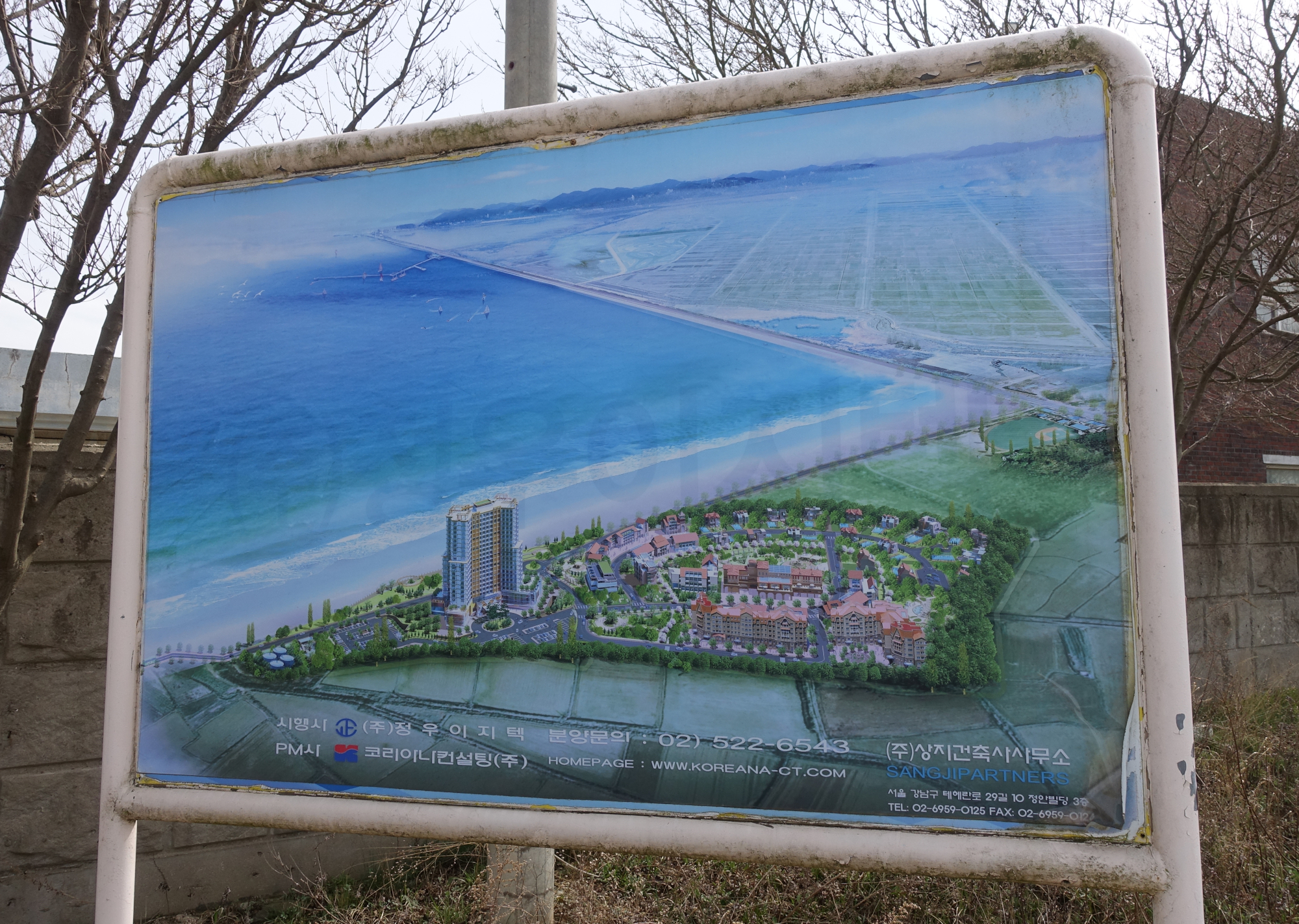
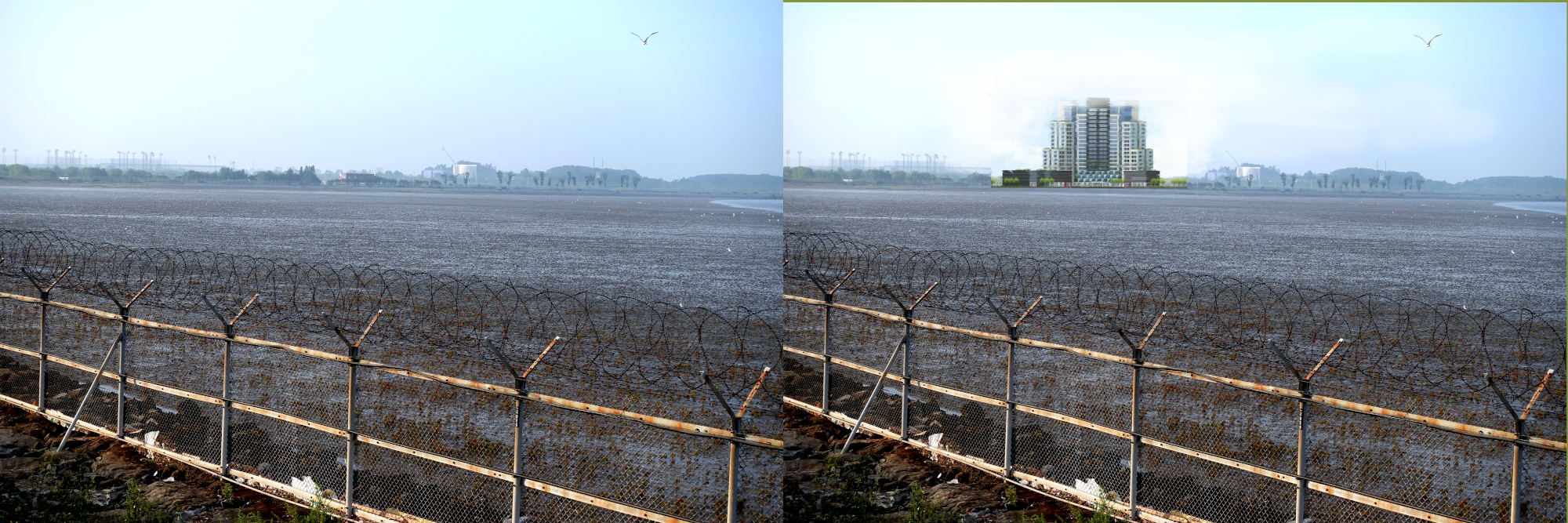
As proposed, the approximately 60m high tourist hotel will be built within 100m of the tidal flat. The hotel complex and associated new roads, running right alongside the tidal flat, will greatly increase disturbance to an area currently used regularly by thousands of shorebirds and internationally important concentrations of several globally threatened waterbird species – with peak counts in 2020 of e.g. more than 9,000 globally Endangered Great Knot Calidris tenuirostris (붉은어깨도요) and more than 200 globally Endangered Black-faced Spoonbill Platalea minor (저어새) .
There is still time to advise against this hotel proposal, especially as it will eventually require permission in one form or another from Hwaseong City and central government bodies, including the regional office of the Cultural Heritage Administration – responsible for preserving National Natural Monuments. These include iconic species like Black-faced Spoonbill (저어새) and Far Eastern Oystercatcher Haematopus osculans (검은머리물떼새), both of which regularly roost in Ramsar-defined internationally important concentrations of 1% or more of population in the area immediately adjacent to the proposed development.
The information summarised below aims to help shorebird experts, Birds Korea members and decision-makers to better understand the potential impacts of this development proposal. We welcome your comments and advice / support in raising concerns with various levels of decision-maker.
At this time especially:
- We are seeking advice and comment on ways to measure and mitigate disturbance impacts on shorebirds, which can then be passed on to decision-makers;
- We are calling for a much more detailed, expert and appropriate environmental impact assessment to be conducted;
And
- We are requesting respectfully, together with other NGOs, that alternative development proposals to this hotel should be considered. For example, in our opinion the establishment of a world-class nature centre, with walking trails and birdwatching hides on the site instead of a tourist hotel would be a much more economically and environmentally sustainable alternative over the long term. This is because the Maehyangri (pronounced “May-Hang-Ree”) tidal flat seems likely to be designated a Wetland Protected Area and a Ramsar site in the near future (perhaps in 2021); and because Hwaseong City, which initiated the Hwaseong Wetlands Project with the East Asian-Australasian Flyway Partnership Secretariat in 2020, continues to promote wetland conservation, including as part of a North-South peace initiative and as part of achieving its own Sustainable Development Goals. A world class wetland needs a world-class nature centre!
More on the Area…
The Hwaseong Wetlands were created in their present form by the reclamation of much of Namyang Bay, following the completion of a 9.81km long outer sea-dyke in 2002. The reclamation process destroyed thousands of hectares of tidal flat, saltmarsh and shallow inshore waters, resulted in the abandonment of several salt-farms used by roosting shorebirds, and caused huge damage to fisheries and some shorebird populations.
The Hwaseong Wetlands currently contains four main wetland types still used by Ramsar-defined internationally important concentrations of waterbirds: (1) the Maehyangri tidal flats and shallow marine waters outside of the outer sea-dyke, (2) the Hwaseong Reclamation Lake, (3) rice-fields, and (4) additional freshwater wetlands created through the reclamation process, including “Pond 13”.
The hotel proposal is for an area immediately adjacent to the highest remaining tidal flats at Maehyangri, used by large numbers of shorebirds during high tide on many dates during the year, including several hundred Eurasian Curlew Numenius arquata (마도요) and Dunlin Calidris alpina (민물도요) in mid-winter and a much higher number and diversity during the two main migration periods (June-October, and March-May). Recent counts in the Hwaseong FNS include more than18,000 shorebirds in October 2020 and again in late March 2021, with the largest concentrations of ~30,000-50,000 shorebirds expected on the Maehyangri tidal flat each late April and early May.
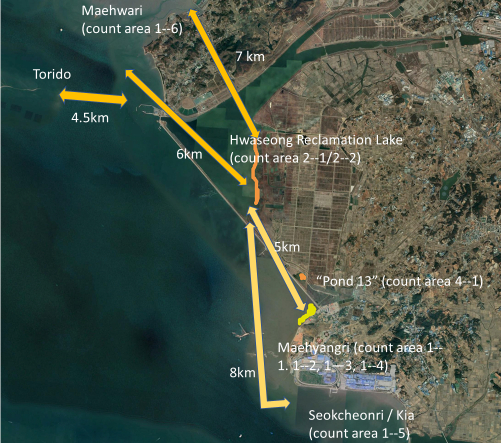
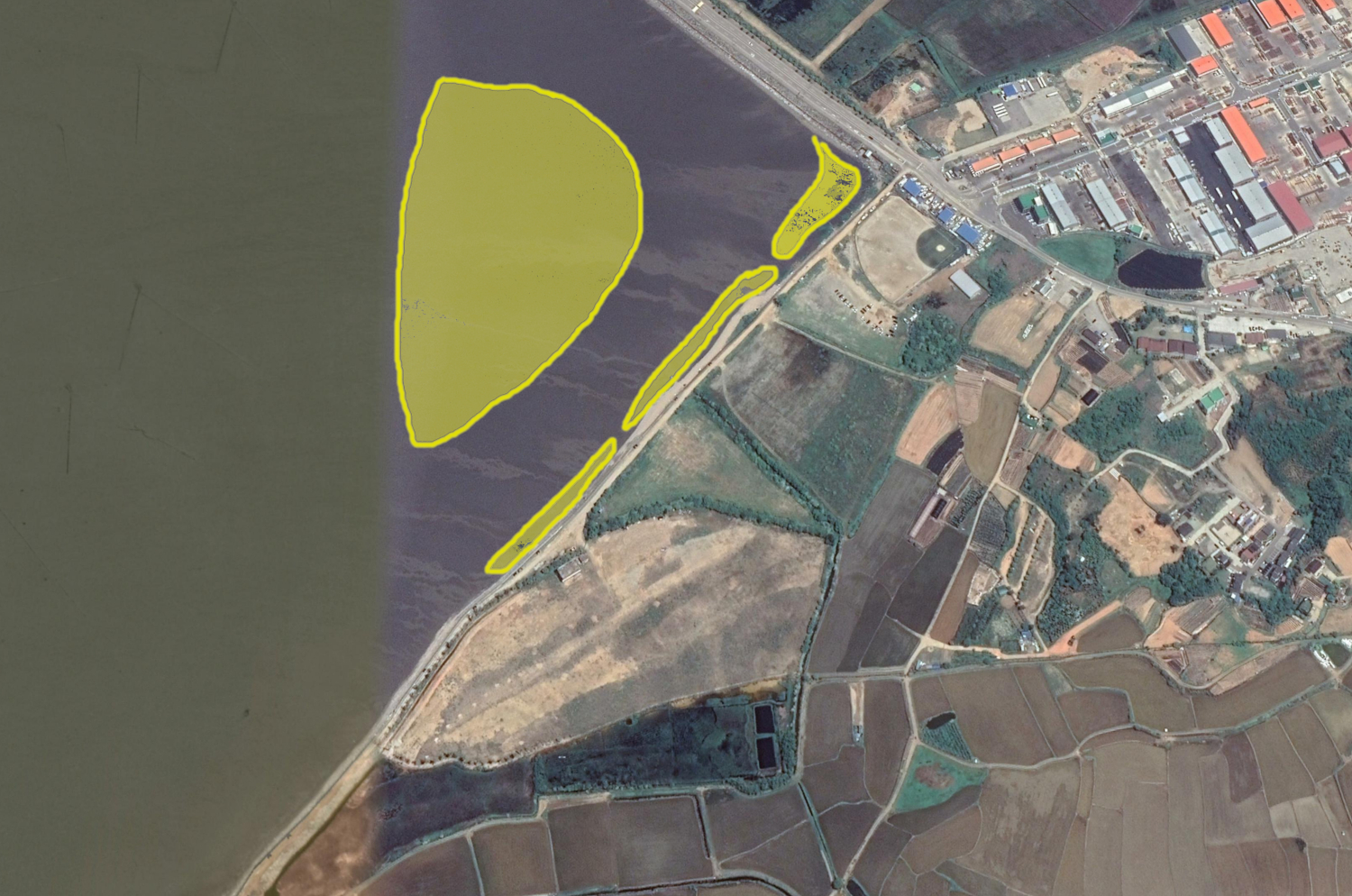


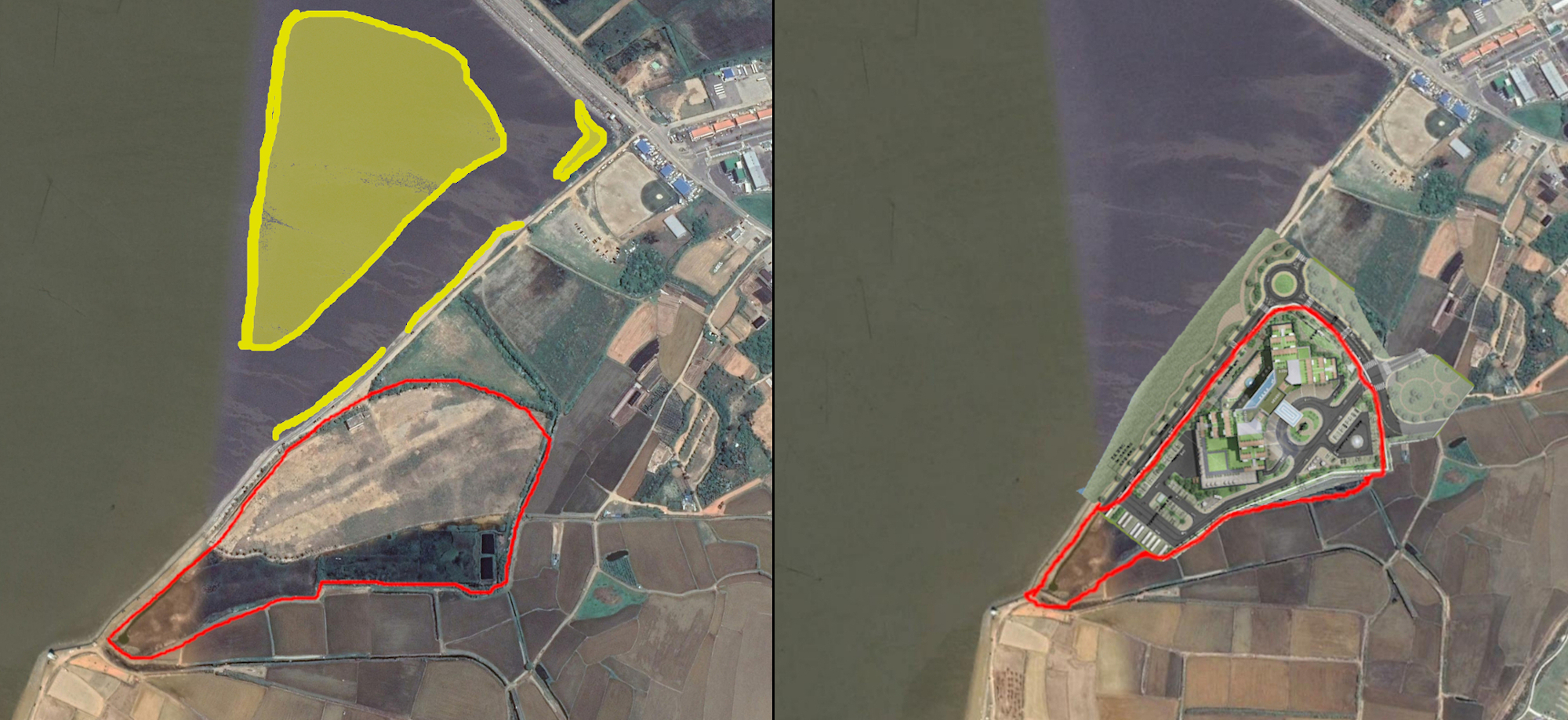

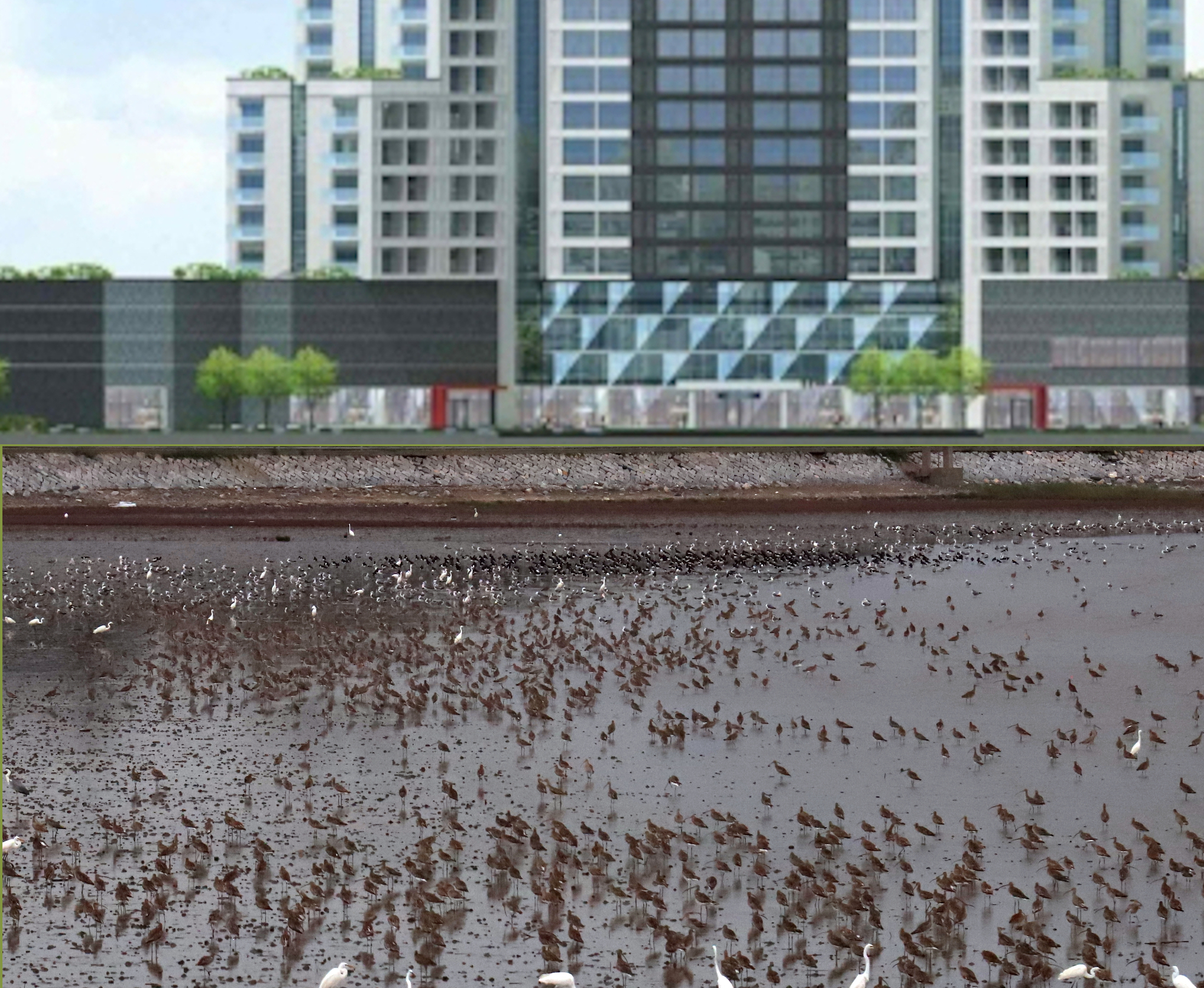
Disturbance
In addition to possible negative impacts on water quality and ecosystem health through the release of huge quantities of hotel wastewater into the tidal flat each day, the most immediate conservation concern comes from the expected huge increase in disturbance to roosting birds.
As modeled by West et al. (2002), numerous small disturbances on species like Oystercatchers can be more damaging than fewer, larger disturbances. And when “the time and energy costs arising from disturbance were included, disturbance could be more damaging than permanent habitat loss.”
Disturbance to birds, defined here as “any deviation from normal behaviour in response to unexpected occurrences in the vicinity of a bird” (Platteeuw & Henkens 1997) is intuitively understood by many researchers and birdwatchers but is very poorly understood by most people.
Disturbance can be caused by e.g. sudden movements or loud sounds near to birds. Initially, most birds stop feeding. If the disturbance gets worse (louder, closer, quicker or more widespread) the same birds will usually take flight. Generally, the strength of response of a bird to an approaching person, or to a car, or to lights or to sudden sounds, can vary substantially depending on the species, on the location, state of tide and weather, and even on the physical condition of an individual bird. In many cases, however, a substantial and sustained increase in disturbance events can lead to the abandonment of preferred roosts.
If the hotel is built as proposed, the shorebirds will be unable to see the horizon, making it much harder to detect and to avoid aerial predators. Many shorebirds show increased tendency to flush and fly longer distances when sight lines are reduced; and most larger shorebirds avoid roosts with restricted sight lines.
As proposed, a road will also be constructed to connect the hotel both to the main road running along the outer sea-dyke to a small group of restaurants in the main harbour at Maehyangri. This road, along the length of the upper tidal flat area, will likely become extremely busy during weekends, especially in the warmer months. Based on other roads in the area, crowds of people will likely park, camp or walk along this road, causing disturbance both during the day and at night.
In addition, as currently proposed the fence along the seawall will be removed, allowing people easy access to the tidal flat.
Each change by itself and all the changes in combination, will massively increase the levels of disturbance and the types of disturbance experienced by waterbirds using the Maehyangri tidal flat. The amount of time that shorebirds can forage and / or roost in a large part of the tidal flat will be substantially reduced.
The cumulative costs of disturbance to waterbirds can be substantial, both on individuals and potentially at the population level, including on Far Eastern Curlew (a long-range migratory shorebird and the Hwaseong City symbol bird). Generally, impacts are considered likely to be most harmful to long-range migratory species with very tight migration schedules and foraging time limited by tides.
Research on two migratory shorebird species in Australia, for example, concluded that the increased energy use associated with as few as ten escape flights per day could have negative consequences to the point of reducing survival or reproductive success (Lilleyman et al. 2016).
During our research at the Hwaseong Wetlands in 2020 conducted as part of the Hwaseong Wetlands Project, we noted that Far Eastern Curlew often initiated flight between 150m and 200m away from the point of disturbance (a distance that matches well with research conducted on the species in Australia: e.g., Glover et al. 2011 and Weston et al. 2012). In addition, on most dates, this species roosted 500m or more from the nearest point of frequent disturbance.
If potentially high levels of multi-point disturbance to shorebirds caused by the hotel development is to be properly assessed and mitigated, then clearly more research needs to be conducted on multiple dates throughout the year before any construction is permitted. This is why we are calling for a proper environmental impact assessment to be conducted, to at least 500m out from the new road and hotel complex.
Ramsar-defined international importance of the Hwaseong Wetlands
It is astonishing that permission could be sought and given for construction of a hotel of this kind so close to the Maehyangri tidal flat. The Hwaseong Wetlands, including the Maehyangri tidal flats were recognized as internationally important for waterbirds as defined by the Ramsar Convention as long ago as 1988. In the decades that followed, as other sites like Saemangeum were destroyed by reclamation, the relative importance of the site has continued to grow. Now, these wetlands are probably the second or third most important site for shorebirds in the ROK. They support many globally threatened species and a diverse array of species which are assessed either as Nationally Endangered by the Ministry of Environment; as specially protected, by the Ministry of Ocean Affairs and Fisheries; and as National Natural Monuments.
In recognition of their high conservation value the Hwaseong Wetlands were finally designated as a Flyway Network Site in 2018. In June 2020, Birds Korea was then invited to lead waterbird surveys at the Hwaseong Wetlands FNS and to review existing datasets on birds for the newly-launched Hwaseong Wetlands Project led by the East Asian-Australasian Flyway Partnership Secretariat and Hwaseong City. As part of the same Project, Hwaseong KFEM was invited to lead awareness-raising activities, and to continue leading citizen science projects, including bird counts; and National KFEM was invited to help connect with policy-makers and decision-makers at the national level. Since January 2021, Gyeonggi KFEM has also jointly been conducting surveys at the site with Birds Korea as part of the Project. Together, working locally, nationally and internationally, we are all dedicated to improving conservation opportunities at this wetland.
Our Project surveys between June 2020 and March 2021 have already found more than 132,000 waterbirds within the FNS; and a review of data gathered between 2015 and 2018 combined with data from our more comprehensive survey in 2020, confirm that at least 16 species of waterbirds occur here regularly in internationally important concentrations (Table 1). Eleven of these waterbird species are tidal flat obligates, including eight species of migratory shorebirds. All of these tidal flat obligate species depend on the Maehyangri tidal flat for feeding and for roosting during most tide cycles.
Table 1. Tidal flat obligate species regularly supported by the Hwaseong Wetlands FNS in Ramsar-defined concentrations of 1% or more of a population (as estimated by Wetlands International 2021) based on the five-year geometric mean of counts made in 2015-2018 and in 2020.
| 1% | 2015 | 2016 | 2017 | 2018 | 2020 | 5yr Geo. mean | % | |
| Far Eastern Oystercatcher | 70-110 | 430 | 468 | 459 | 643 | 623 | 517 | ~5% |
| Grey Plover | 1000 | 1021 | 1800 | 680 | 1065 | 1450 | 1140 | 1% |
| Mongolian Plover | 390 | 800 | 430 | 500 | 420 | 870 | 575 | >1% |
| Far Eastern Curlew | 320 | 500 | 1063 | 470 | 1150 | 2275 | 918 | ~3% |
| Eurasian Curlew | 1000 | 3300 | 4220 | 3106 | 2680 | 3700 | 3374 | >3% |
| Bar-tailed Godwit | 1500 | 1029 | 930 | 3583 | 2500 | 1760 | 1721 | >1% |
| Great Knot | 2900 | 3001 | 8000 | 6023 | 34900 | 9625 | 8655 | 3% |
| Terek Sandpiper | 500 | 140 | 750 | 550 | 970 | 1710 | 625 | >1% |
| Saunders’s Gull | 85 | 91 | 193 | 398 | 203 | 138 | 182 | 2% |
| Black-faced Spoonbill | 20-48 | 124 | 146 | 214 | 160 | 254 | 173 | >4% |
| Chinese Egret | 35 | 132 | 83 | 45 | 97 | 70 | 80 | >2% |
Shorebirds and tide-related movements
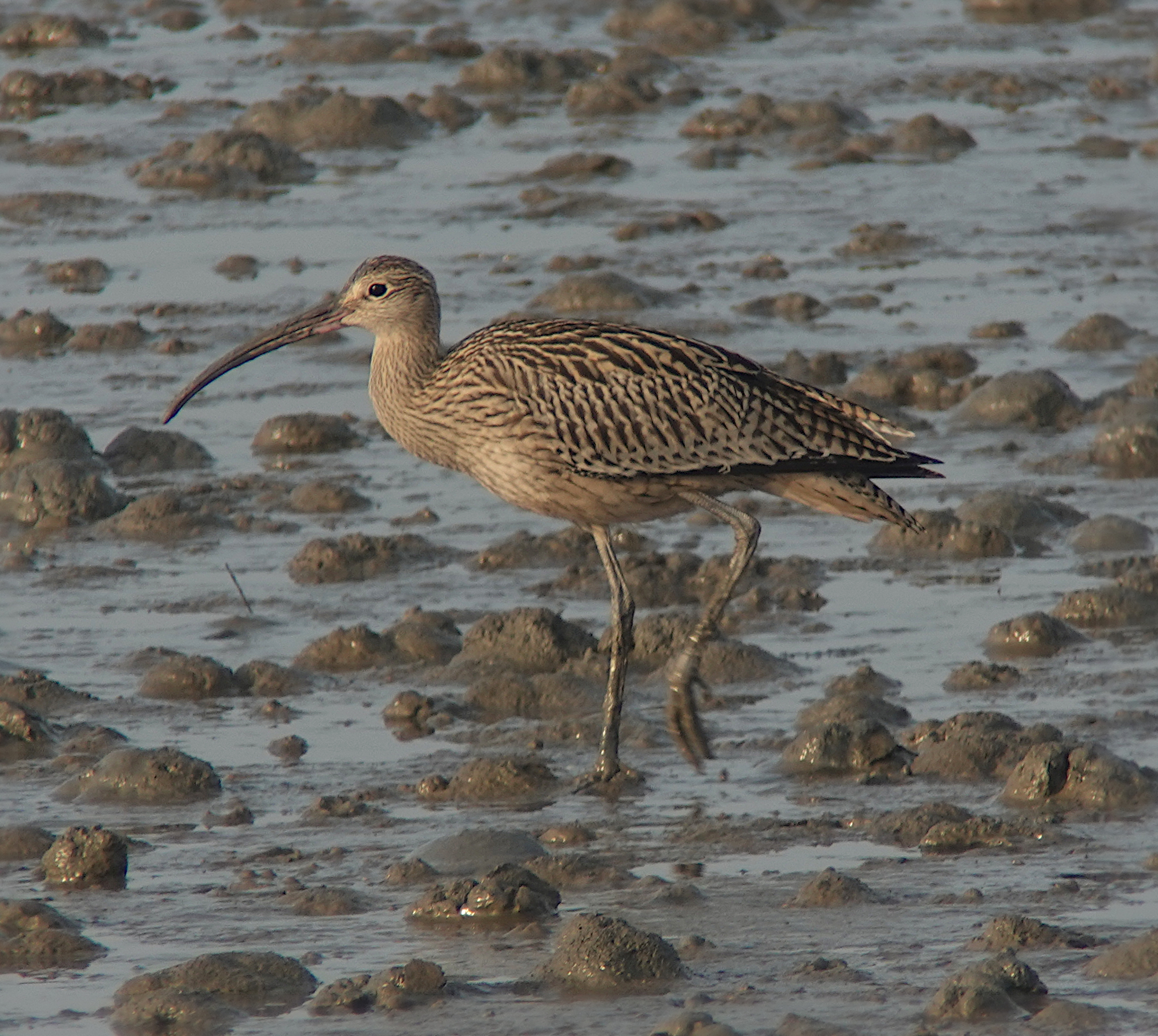
On most dates, at low tide the vast majority of shorebirds feed across 900-1000ha of the exposed Maehyangri tidal flats. Then, as elsewhere during each tide cycle, twice each 24 hours, shorebirds are then pushed back towards dry land by the rising tide. The higher the tide, the more quickly the shorebirds are pushed landward, and the longer they are unable to feed.
In 2021, based on tide heights at the adjacent Pyeongtaek Port, high tides in the Hwaseong Wetlands will range from a low neap high of 5.53m to a highest high tide of 9.68m (http://www.khoa.go.kr/swtc/main.do).
On dates with high tides below 730cm, extensive tidal flats remain exposed and shorebirds can currently roost and feed largely undisturbed by people >500m from shore.
During high tides of between about 730cm and 840cm (a total of 247 tide cycles in 2021), however, shorebirds are forced closer and closer to the land, becoming increasingly vulnerable to the effects of disturbance.
On dates with tides higher than about 840cm (a total of 213 tide cycles in 2021), the whole of Maehyangri tidal flat becomes inundated with water – and shorebirds get pushed off the tidal flat, and are forced to use alternative roosts.
In the absence of disturbance, preferred alternative roosts for most species, including Far Eastern Curlew, are a shallow pond the other side of the outer sea dyke 1.2km from the tidal flat roost; and when water levels are kept low enough, at the southern end of the Hwaseong Reclamation Lake, 5-6km on a straight line from the tidal flat roost.

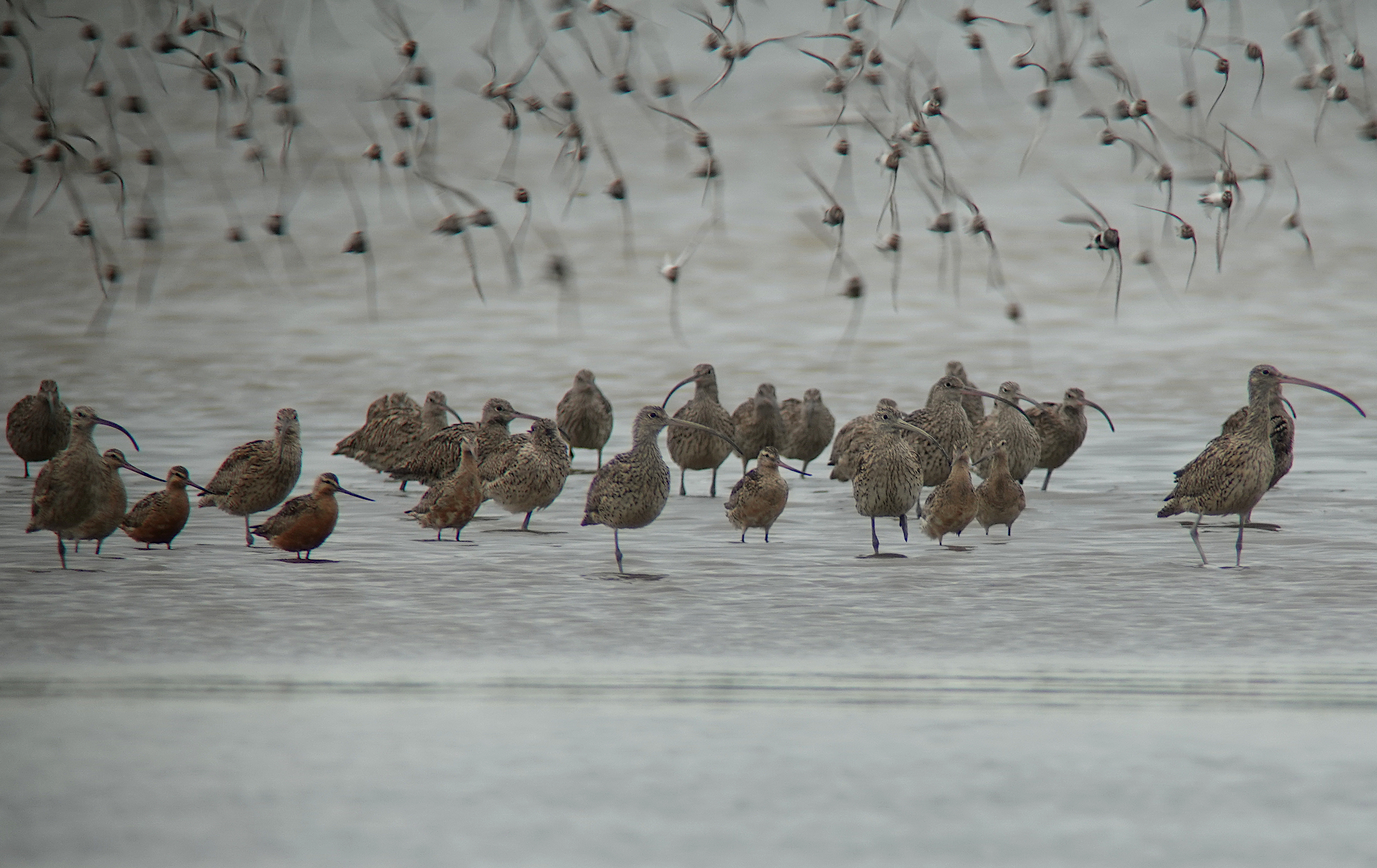
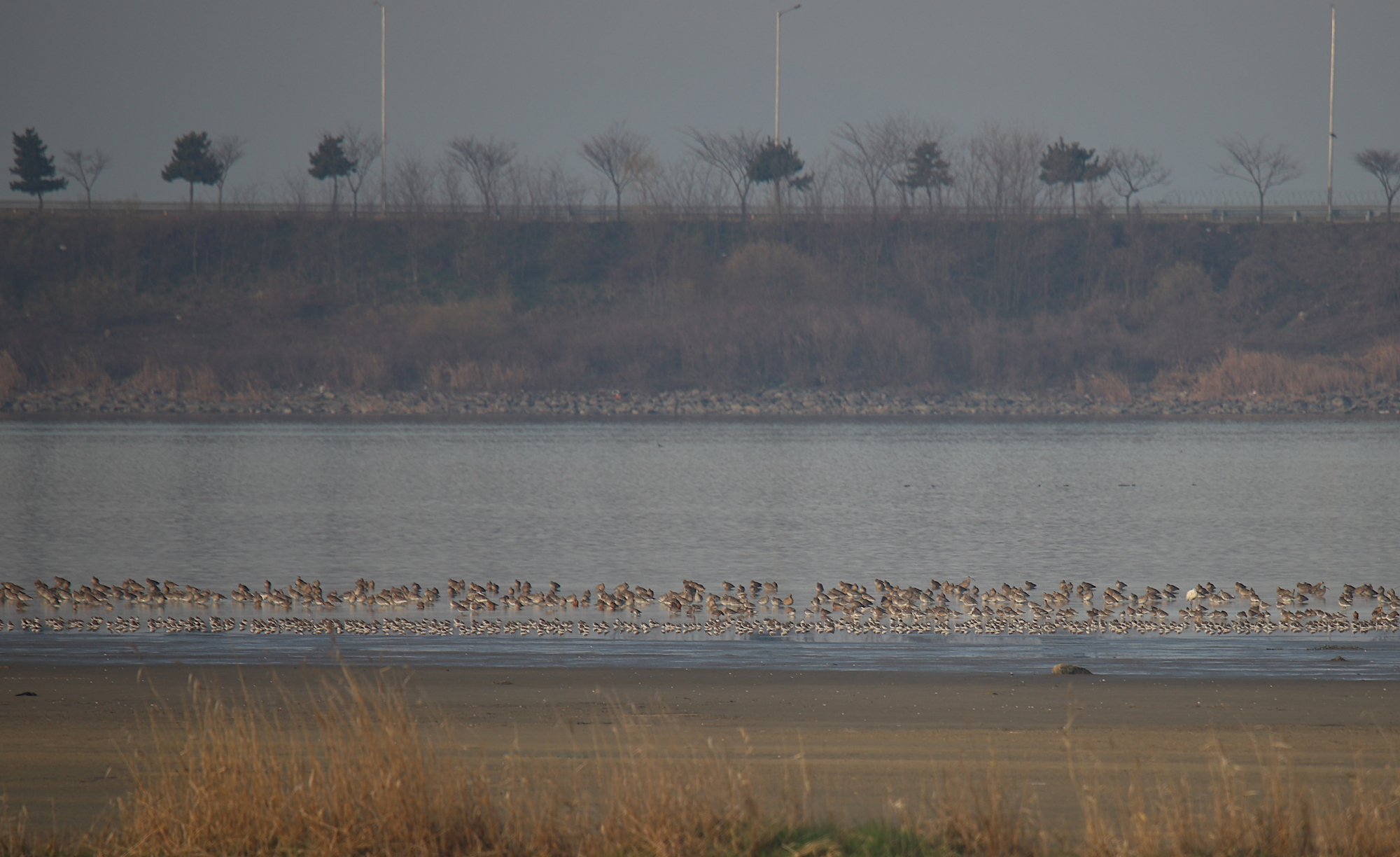
Our surveys found, however, that curlews were often flushed from the shallow pond by photographers; and in August water levels were kept too high in the Hwaseong Reclamation Lake, preventing shorebirds from roosting there. Instead, it appeared that the curlews and some other species were forced to stay in flight for 2-3 hours, until tides started to fall once more.
Maintaining populations of shorebirds at the Hwaseong Wetlands and in the ROK as a whole, as aimed for by national legislation and as called for by the Ramsar Convention, really will require a paradigm shift in the way that people think about wetlands and biodiversity. Appropriate management of the FNS is required to help reduce disturbance at key roost-sites; and water levels in the Hwaseong Reclamation Lake, currently managed entirely for agriculture and pollution control, need also to factor in biodiversity conservation.
Birds Korea will continue to do all we can to gather and share best information and to support decision-makers with honest, science-based assessments relevant to the conservation of biodiversity.
We welcome your opinions and support toward this end. Thank you.
References
Glover, H. K., M. A. Weston, G. S. Maguire, K. K. Miller and B. A. Christie. 2011. Towards ecologically meaningful and socially acceptable buffers: Response distances of shorebirds in Victoria, Australia, to human disturbance. Landscape and Urban Planning 103(3-4): 326-334.
Lilleyman, A., D. C. Franklin, J. K. Szabo and M. J. Lawes 2016. Behavioural responses of migratory shorebirds to disturbance at a high-tide roost. Emu 116(2): 111.
Platteeuwm, M. & Henkens, J. 1997. Possible impact of disturbance to waterbirds: individuals, carrying capacity and populations. Wildfowl, 48: 225-236.
West, A.D., Goss-Custard, J. D., Stillman, R. A., Caldow, R. W. G., le V. dit Durell, S. E. A. & McGrorty, S. 2020. Predicting the impacts of disturbance on shorebird mortality using a behaviour-based model. Biological Conservation, Volume 106, Issue 3, August 2002: 319-328
Weston, M. A., McLeod, E. M., Blumstein, D. T., & Guay, P.-J. 2012. A review of flight initiation distances and their application to managing disturbance to Australian birds. Emu, 112: 269-286.

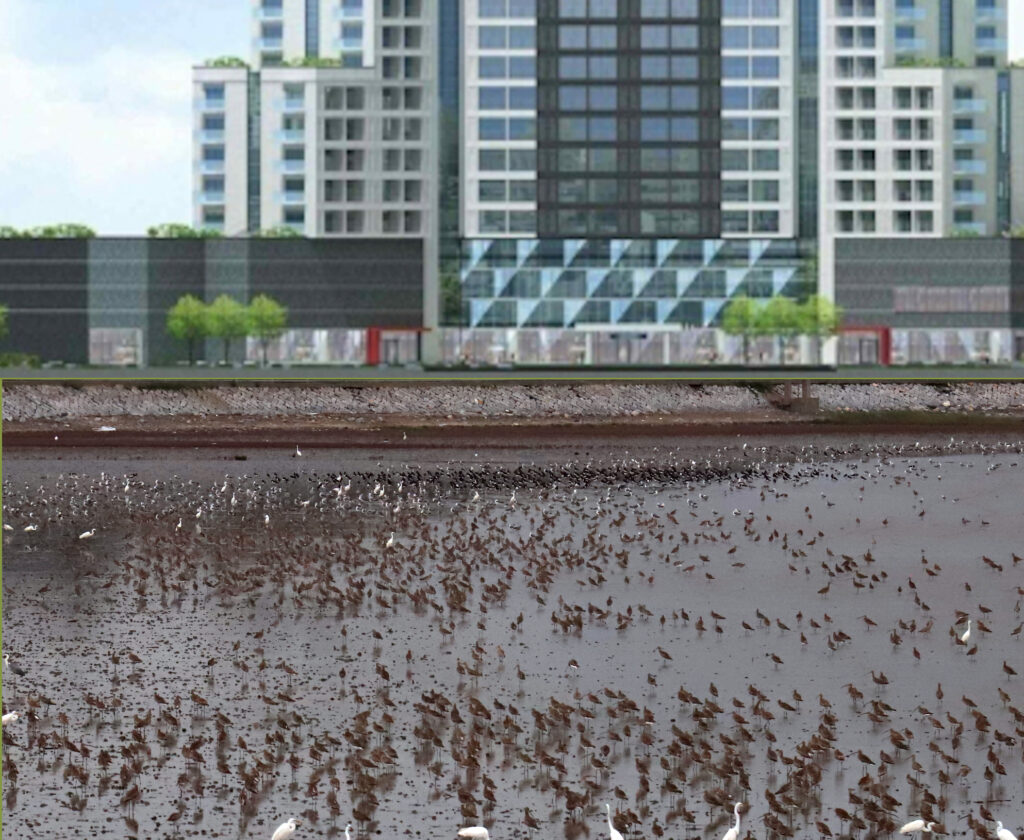
The Hwaseong Wetland FNS is critical for population maintenance of many waterbirds along the flyway. Development project at the site and surrounding region should be coordinated with conservation of waterbirds and their habitat. Potential impacts of development projected on birds should be assessed before implementation. A bird-friendly project is the only choice to achieve the target of sustainable development.